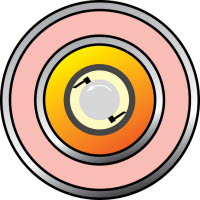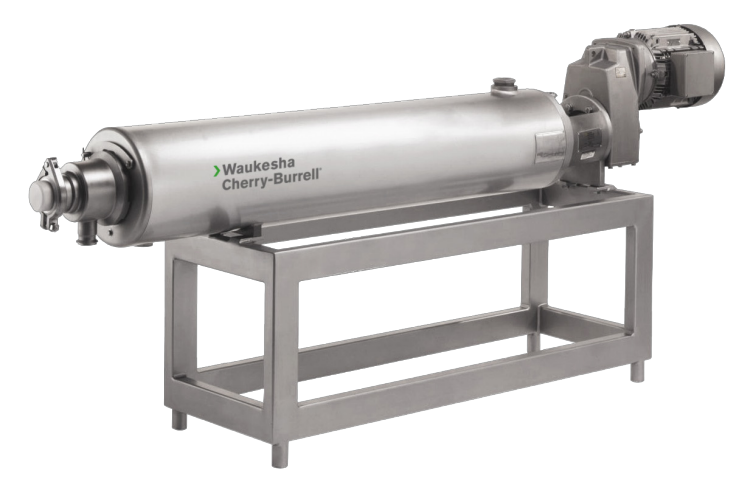Plate heat exchangers are a common feature of many food and beverage processing plants. Their effectiveness is assured by the design which enables very fluid products to spread across the surface of the plates which transfer heat and facilitate speedy temperature change. The only downside is that for more viscous products they are limited by temperature and pressure constraints and they may not be suitable for all products as they have very narrow gaps between the plates.
Often a way to get round these particular problems is to opt for a shell-and- tube heat exchanger, these designs being suitable both for vertical and horizontal positioning. These heat exchangers are also very different in the way they operate and are capable of applications for which plate heat exchangers may not be wholly suitable.
Typical applications for this type of heat exchanger can be found in oil refineries and large chemical processes and where higher-pressure requirements have to be satisfied. A shell-and-tube heat exchanger consists of a shell containing a bundle of tubes, with one fluid running through the tubes and another fluid flowing over the surfaces of the tubes to transfer heat between the two fluids. Even so these designs have their shortcomings, particularly when it comes to more viscous products.
For applications where the fluids contain solids, or are of a viscous nature, scraped surface heat exchangers present a quick and efficient manner for transferring heat into and out of the fluid. For food processing applications they also have the benefit of retaining the food structure. These heat exchangers use blades to continuously scrape the inside surface of the heating chamber, this action protecting highly viscous fluids from being burned on the heating surface because the product is exposed to heat for just a short time.
Waukesha Cherry-Burrell is probably better known for its pump technologies, but it has an impressive track record for its scraped surface heat exchangers. WCB’s Votator® units are used in many market sectors, ranging from chemicals and petroleum to food and pharmaceuticals, where their heat transfer performance and ability to handle viscous products are considered to be superior to tubular and plate heat exchangers. Coupled with this is their ability to offer a uniform, controllable and repeatable performance that allows continuous processing operations to replace batching operations.
The scraped surface heat exchanger uses a relatively simple concept to deliver high efficiency and productivity. Heating or cooling a continuously moving product is achieved by providing a large heat transfer surface for a small amount of product in a confined space. In the case of WCB’s Votator®, a mutator shaft fitted with blades rotates within a tube, with the product passing through an annulus formed by the shaft and heat transfer tube. The heating or cooling medium flows through a jacket surrounding the heat transfer tube. The unit is insulated to minimise energy loss and to protect personnel and this is enclosed with a stainless steel cover, see below.

In operation, the blades fitted to the rotating shaft continuously scrape product film from the heat transfer tube wall, thereby enhancing heat transfer and agitating the product to produce a homogenous mixture. The amount of time the product remains within the heat exchanger for a given rate is controlled by the diameter of the shaft, which controls the product. Small shaft heat exchangers provide a large annulus for longer residence time and will handle products with a large solid content. Large shaft heat exchangers provide a smaller annulus for high velocity and turbulence with high heat transfer rates and short product residence time in the unit.
In order to accommodate the widest range of products this type of heat exchanger is offered with a choice of concentric, eccentric and oval tubes. For most applications, the shaft is mounted in the centre of a concentric heat transfer tube. An off-centered shaft mount, or eccentric design is recommended for viscous and sticky products. This shaft arrangement increases product mixing and reduces the mechanical heat load. Oval tubes are used to process extremely viscous products. This design eliminates product channeling within the tube, reduces mechanical heat by the double cam action of the scraper blades and balances the internal product force to prevent shaft deflection. When considering the selection of heat exchanger transfer tubes, thermal conductivity and thermal thickness are the key issues.
The thickness of the tube wall has to minimise heat transfer resistance whilst maximising structural stability. Pure nickel tubes will provide the necessary thermal conductivity. In order to combat wear from the scraper blades and abrasive products, the inside of the tube needs to be chrome plated and polished to a high finish. For applications where acidic products are encountered, stainless steel tubes enable enhanced heat transfer and which accommodate cleaning agents for aseptic processing.
WCB’s Votator® II scraped heat exchangers are intended for applications where extremely thick and viscous products require the cam action of the eccentric or oval design, the Votator® II is very much a heavy-weight unit. This level of construction means that it is more consistent in controlling the temperature. Using direct drive gear motors rather than belt drives, this unit accepts the self-aligning mutator shaft thereby eliminating the need for a drive stub shaft and coupling. It also offers the benefit of being far quieter than belt driven units.
In any processing environment, long service life and easy maintenance are factors that influence plant efficiency. In the case of the Votator® II, WCB has paid considerable attention to the time taken both in disassembling and reassembling units for regular inspection and servicing. Boltless V-lock heads allow the shaft to be removed without the use of any special tools and after servicing or inspection, the unit is reassembled by simply inserting the self-aligning spline end of the shaft into the hollow shaft of the gear motor. There is no complex shaft coupling, no sensitive stub alignment or vulnerable drive belts to service.
The range of applications and products for which this type of heat exchanger can be used is considerable, encompassing delicate foods, meat, chemicals and pharmaceuticals.
Where heat sensitive products are involved, the short amount of time that the product is exposed to heat means that it is not adversely affected. This action also prevents product from crystallizing. Viscous products are processed far more efficiently than conventional plate or tubular heat exchangers. High heat transfer rates are induced by the continuous scraping action and constant agitation causes turbulent flow and more consistent heating or cooling. In addition, agitation eliminates stagnant areas and product build-up, therefore making cleaning that much easier.


